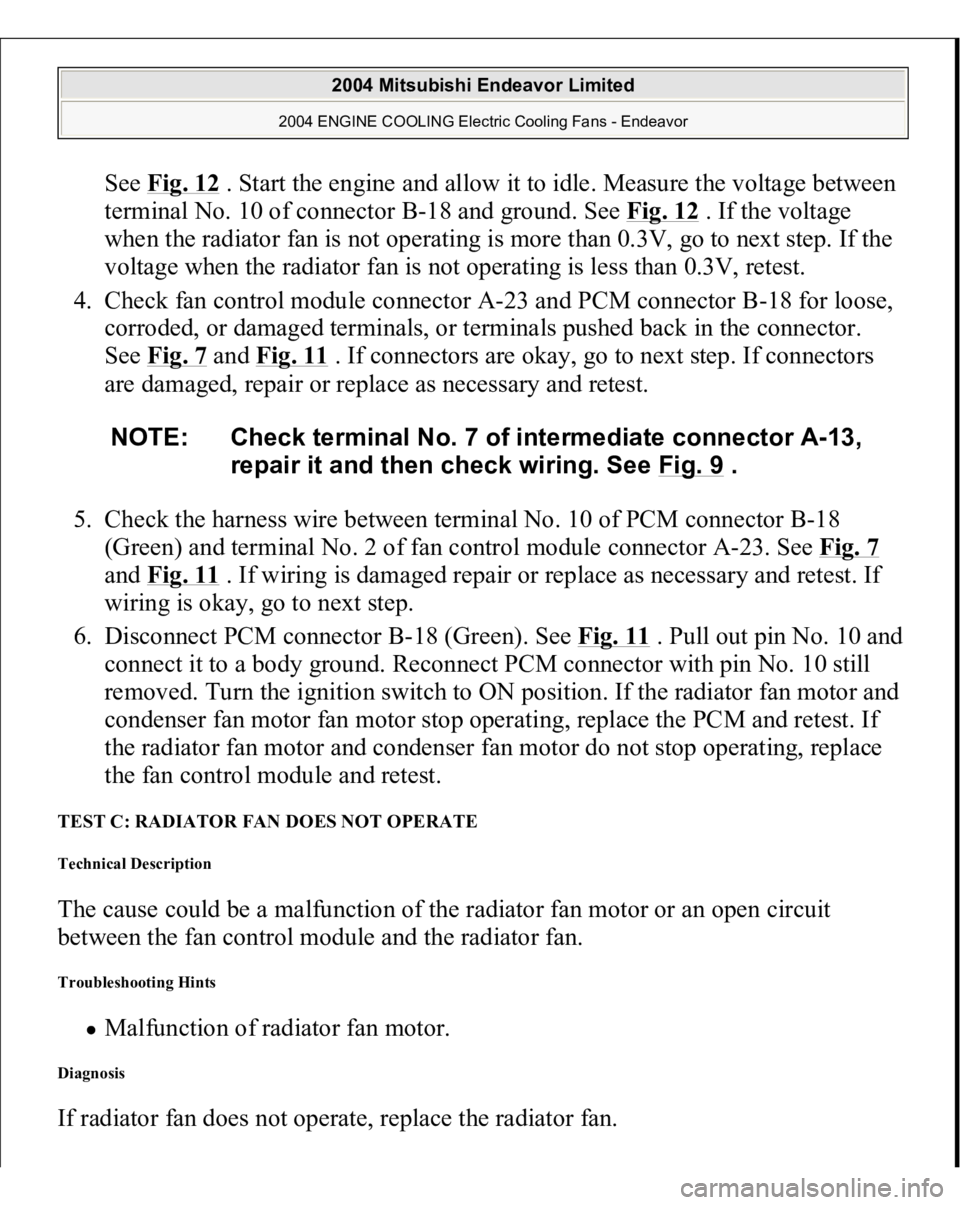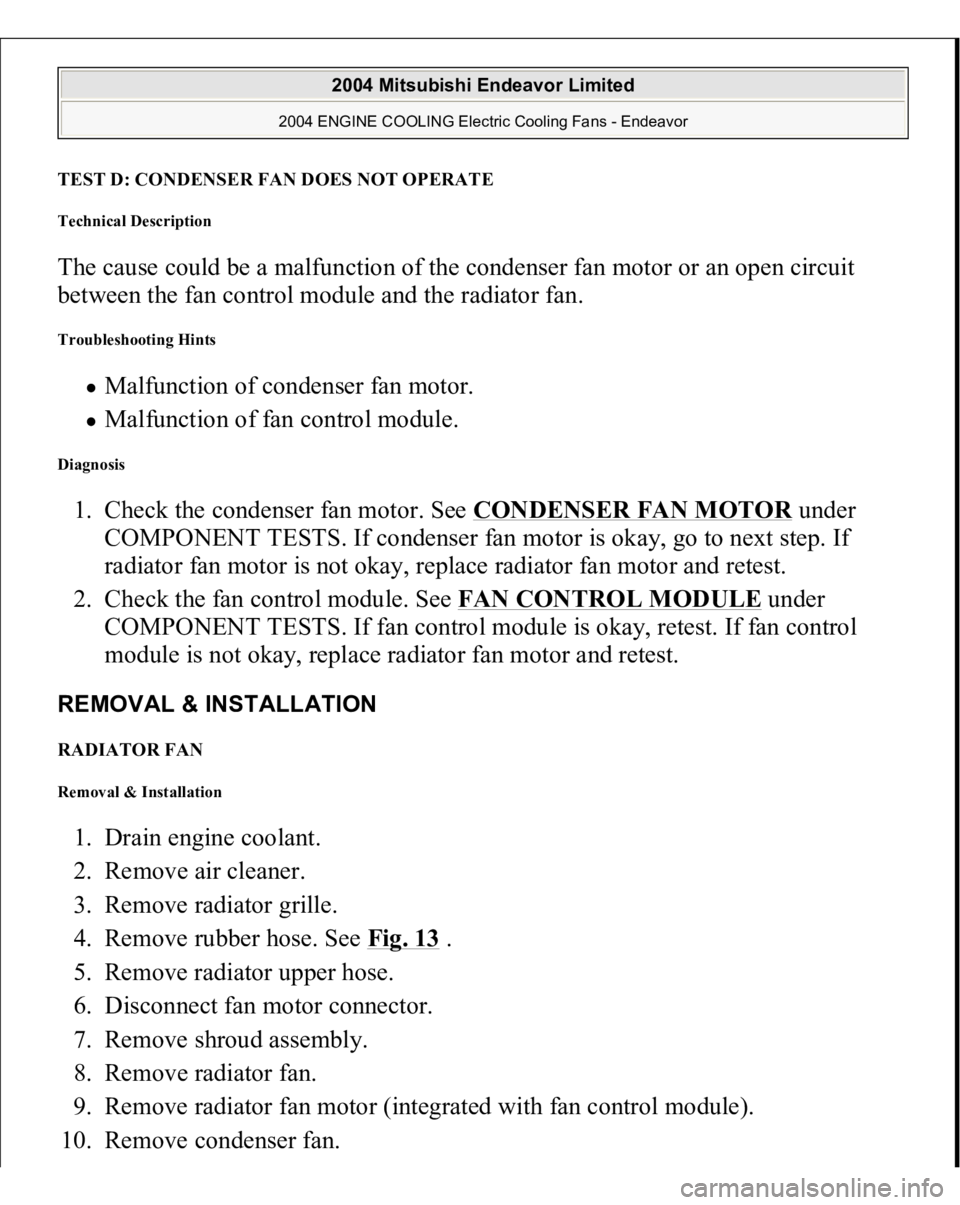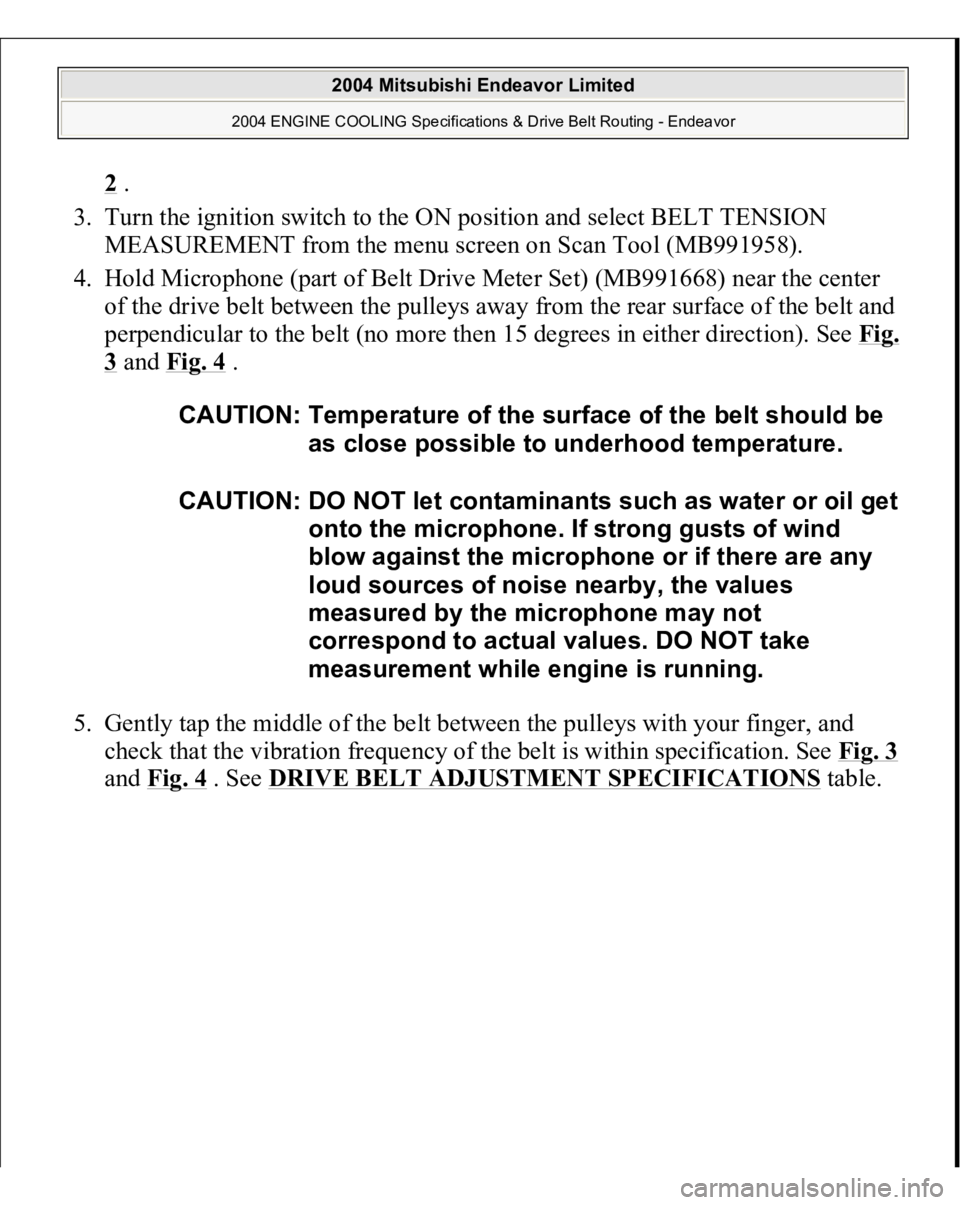Page 808 of 3870

See Fig. 12
. Start the engine and allow it to idle. Measure the voltage between
terminal No. 10 of connector B-18 and ground. See Fig. 12
. If the voltage
when the radiator fan is not operating is more than 0.3V, go to next step. If the
voltage when the radiator fan is not operating is less than 0.3V, retest.
4. Check fan control module connector A-23 and PCM connector B-18 for loose,
corroded, or damaged terminals, or terminals pushed back in the connector.
See Fig. 7
and Fig. 11
. If connectors are okay, go to next step. If connectors
are damaged, repair or replace as necessary and retest.
5. Check the harness wire between terminal No. 10 of PCM connector B-18
(Green) and terminal No. 2 of fan control module connector A-23. See Fig. 7
and Fig. 11
. If wiring is damaged repair or replace as necessary and retest. If
wiring is okay, go to next step.
6. Disconnect PCM connector B-18 (Green). See Fig. 11
. Pull out pin No. 10 and
connect it to a body ground. Reconnect PCM connector with pin No. 10 still
removed. Turn the ignition switch to ON position. If the radiator fan motor and
condenser fan motor fan motor stop operating, replace the PCM and retest. If
the radiator fan motor and condenser fan motor do not stop operating, replace
the fan control module and retest.
TEST C: RADIATOR FAN DOES NOT OPERATE Technical Description The cause could be a malfunction of the radiator fan motor or an open circuit
between the fan control module and the radiator fan. Troubleshooting Hints
Malfunction of radiator fan motor.
Diagnosis If radiator fan does not operate, replace the radiator fan.
NOTE: Check terminal No. 7 of intermediate connector A-13,
repair it and then check wiring. See Fig. 9
.
2004 Mitsubishi Endeavor Limited
2004 ENGINE COOLING Electric Cooling Fans - Endeavor
Page 809 of 3870

TEST D: CONDENSER FAN DOES NOT OPERATETechnical Description The cause could be a malfunction of the condenser fan motor or an open circuit
between the fan control module and the radiator fan. Troubleshooting Hints
Malfunction of condenser fan motor. Malfunction of fan control module.
Diagnosis 1. Check the condenser fan motor. See CONDENSER FAN MOTOR
under
COMPONENT TESTS. If condenser fan motor is okay, go to next step. If
radiator fan motor is not okay, replace radiator fan motor and retest.
2. Check the fan control module. See FAN CONTROL MODULE
under
COMPONENT TESTS. If fan control module is okay, retest. If fan control
module is not okay, replace radiator fan motor and retest.
REMOVAL & INSTALLATION RADIATOR FAN Removal & Installation 1. Drain engine coolant.
2. Remove air cleaner.
3. Remove radiator grille.
4. Remove rubber hose. See Fig. 13
.
5. Remove radiator upper hose.
6. Disconnect fan motor connector.
7. Remove shroud assembly.
8. Remove radiator fan.
9. Remove radiator fan motor (integrated with fan control module).
10. Remove condenser fan.
2004 Mitsubishi Endeavor Limited
2004 ENGINE COOLING Electric Cooling Fans - Endeavor
Page 810 of 3870
11. Remove condenser fan motor.
12. To install, reverse removal procedures.
Fig. 13: Exploded View Of Radiator & Radiator Fans
Courtesy of MITSUBISHI MOTOR SALES OF AMERICA.
WIRING DIAGRAMS See COOLING FAN in appropriate SYSTEM WIRING DIAGRAMS article in
ELECTRICAL.
2004 Mitsubishi Endeavor Limited
2004 ENGINE COOLING Electric Cooling Fans - Endeavor
Page 1066 of 3870

2004 ENGINE COOLING
Specifications & Drive Belt Routing - Endeavor
COOLING SYSTEM BLEEDING 1. Using LLC Changer (MB991871), refill cooling system with appropriate
mixture between 30-60% anti-freeze (depending on weather conditions). See
Fig. 1
. Typically a solution of 50% anti-freeze and 50% distilled water is
sufficient for most areas. A solution of 50% anti-freeze and 50% water has a
freezing point of -32.8°F (-31°C).
2. Reinstall the radiator cap.
3. Start the engine and let it warm up until the thermostat opens.
4. After repeatedly revving the engine up to 3000 RPM several times, shut off the
engine.
5. Remove the radiator cap after engine has become cold, completely fill the
radiator with coolant. Reinstall the cap.
6. Ensure coolant in the reserve tank is between the FULL and LOW marks. Add
coolant if necessar
y.
CAUTION: DO NOT use alcohol or methanol anti-freeze or any
engine coolants mixed with alcohol or methanol anti-
freeze. The use of an improper anti-freeze can cause
corrosion of the aluminum components.
CAUTION: DO NOT overfill the reserve tank.
2004 Mitsubishi Endeavor Limited
2004 ENGINE COOLING Specifications & Drive Belt Routing - Endeavor
2004 Mitsubishi Endeavor Limited
2004 ENGINE COOLING Specifications & Drive Belt Routing - Endeavor
Page 1067 of 3870
Fig. 1: Bleeding Cooling System
Courtesy of MITSUBISHI MOTOR SALES OF AMERICA.
ADJUSTMENTS CHECKING DRIVE BELTS Using a Scan Tool (Frequency) 1. Connect Belt Tension Meter Set (MB991668) to Scan Tool (MB991958). See
Fig. 2
.
2. Connect Scan Tool
(MB991958
) to the Data Link Connector
(DLC
). See Fi
g.
CAUTION: To prevent damage, always turn the ignition switch
to the LOCK position before connecting or
disconnecting Scan Tool (MB991958).
2004 Mitsubishi Endeavor Limited
2004 ENGINE COOLING Specifications & Drive Belt Routing - Endeavor
Page 1068 of 3870

2 .
3. Turn the ignition switch to the ON position and select BELT TENSION
MEASUREMENT from the menu screen on Scan Tool (MB991958).
4. Hold Microphone (part of Belt Drive Meter Set) (MB991668) near the center
of the drive belt between the pulleys away from the rear surface of the belt and
perpendicular to the belt (no more then 15 degrees in either direction). See Fi
g.
3 and Fig. 4
.
5. Gently tap the middle of the belt between the pulleys with your finger, and
check that the vibration frequency of the belt is within specification. See Fig. 3
and Fig. 4
. See DRIVE BELT ADJUSTMENT SPECIFICATIONS
table.
CAUTION: Temperature of the surface of the belt should be
as close possible to underhood temperature.
CAUTION: DO NOT let contaminants such as water or oil get
onto the microphone. If strong gusts of wind
blow against the microphone or if there are any
loud sources of noise nearby, the values
measured by the microphone may not
correspond to actual values. DO NOT take
measurement while engine is running.
2004 Mitsubishi Endeavor Limited
2004 ENGINE COOLING Specifications & Drive Belt Routing - Endeavor
Page 1069 of 3870
Fig. 2: Checking Vibration Frequency
Courtesy of MITSUBISHI MOTOR SALES OF AMERICA.
2004 Mitsubishi Endeavor Limited
2004 ENGINE COOLING Specifications & Drive Belt Routing - Endeavor
Page 1070 of 3870
Fig. 3: Checking Vibration Frequency (Generator Belt)
Courtesy of MITSUBISHI MOTOR SALES OF AMERICA.
2004 Mitsubishi Endeavor Limited
2004 ENGINE COOLING Specifications & Drive Belt Routing - Endeavor